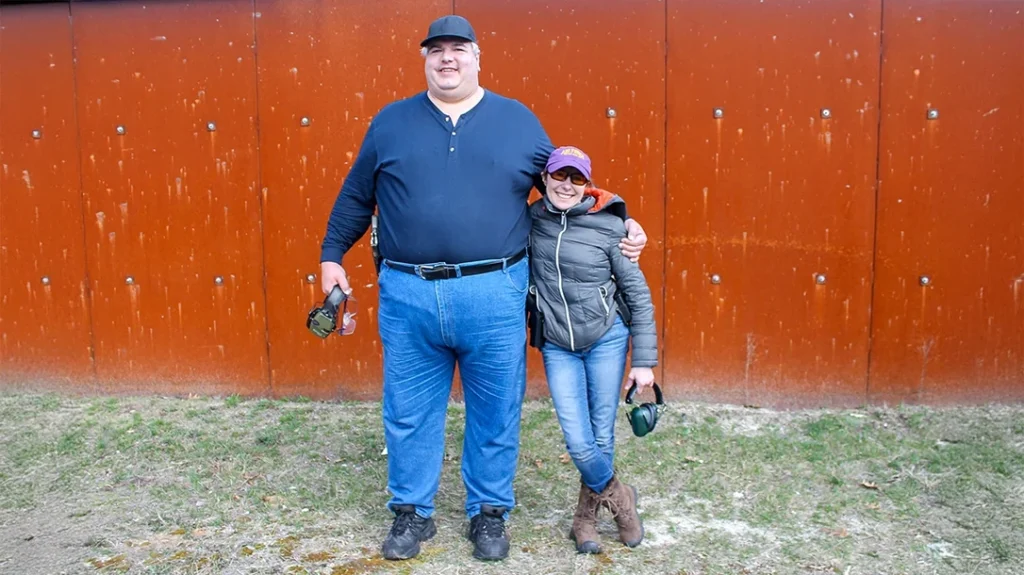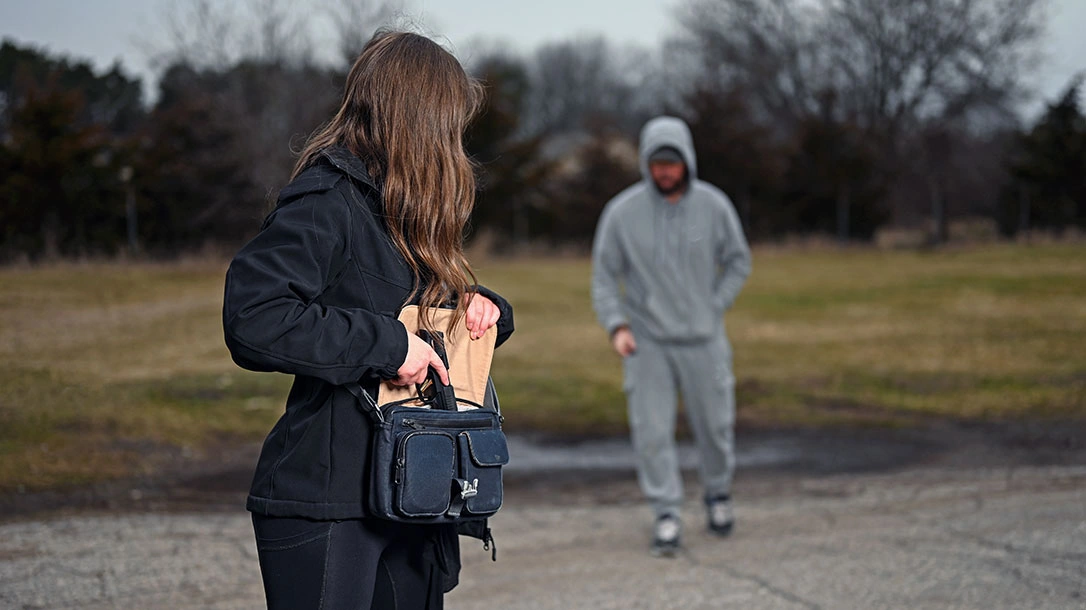In our society, women are often called “the fair sex” or “the gentle sex.” “Sugar and spice and everything nice.” Thus, at least some of the public is shocked when a woman kills a man in self-defense.
Case Studies when Women Have to Kill in Self-Defense
Retired psychology professor Glenn E. Meyer used to do mock trials at a university in Texas. He would assemble two mock juries, then “try cases” with each jury getting a slightly different fact pattern or trial strategy approach.
In one such experiment, the case was a shooting with the defense claiming justifiable homicide. The only difference was that one jury got a female defendant and the other, a male. The jury was harder on the female than the male. This indicates that some people in the jury pool are particularly disturbed when a woman resorts to lethal violence.
Advertisement — Continue Reading Below
The Center for Constitutional Rights had this to say about a landmark case in this vein, Washington v. Yvonne Swan Wanrow: the Washington State Supreme Court ruled that the jury should have been allowed to consider “perceptions of the situation, including those perceptions which were the product of our nation’s long and unfortunate history of sex discrimination.”
Case One: Woman Kills Child Predator
The deceased was a neighbor of Wanrow’s. He was a convicted child molester who stood over six feet tall and weighed over 200 pounds, and had raped a local seven-year-old girl. Ms. Wanrow was 5 feet 4 inches tall and weighed 120 pounds. She was wearing a cast on an injured foot when the man came at her in a house full of children, and she shot him dead.
She was convicted of Second Degree Murder, but as noted, the court of appeals reversed the conviction. I believe she would have been acquitted if properly defended in a second trial. However, exhausted by the ordeal, Wanrow accepted a deal in which she pled to Manslaughter with no time served.
Advertisement — Continue Reading Below
Case Two: Texas v. Pearl Reed
Let’s be clear: we’re talking self-defense cases here, not “crimes of passion.”
In her book “Murder and the Reasonable Man,” law professor Cynthia Lee writes of a different courtroom prejudice against women. Case in point, Texas v. Pearl Reed.
Advertisement — Continue Reading Below
Many years ago, Texas law considered it justified for a cuckolded husband to kill his wife’s lover (though not his wife) if he caught the two in flagrante delicto. Reed had fatally shot her husband’s mistress when she caught them in the act and had been convicted of Murder.
Her appeal claimed in essence that she should have been afforded the same “free shot” as a male spouse would have in the same situation.
Writes Lee, “The Texas Court of Appeals deferred to the legislature rather than taking action to rectify the gender inequity reflected in the statute.”
Advertisement — Continue Reading Below
“Expert testimony can be used effectively to neutralize stereotypical prejudices and ideas which interfere with a proper consideration of a woman’s defense,” writes Elizabeth Bochnak, co-founder of the Women’s Self-Defense Law Project, in her book “Women’s Self-Defense Cases: Theory and Practice.”
Case Three: California v. Inez Garcia
Another famous example from the past is Case Three, California v. Inez Garcia. She was raped by one man as his 300-pound accomplice held a large knife on her. When the attack was over, they threatened to kill her if she talked.
Later that night, she encountered them on the street, and when the big one came at her with his knife, she unleashed eight rounds of .22 Long Rifle. She hit him with four and killed him with one that pierced his brain. She was charged with Murder.
Advertisement — Continue Reading Below

Charles Geary, her lawyer, used an impaired capability defense: she wasn’t too smart to begin with, and was traumatized by the rape and not responsible for her actions. She was convicted.
When the appellate court overturned the conviction, her new attorney, Susan Jordan, focused her strategy on straightforward self-defense. The man she killed was coming at her with a knife! The second jury agreed, and the courtroom audience cheered when their Not Guilty verdict was announced.
Advertisement — Continue Reading Below
A lesson: jurors are not forgiving of impaired capability defenses. “It’s not my client’s fault because he or she was traumatized/drunk/doped up/crazy/out of their mind (pick one)” often results in the jury thinking “Your client gets whacky and kills people and you want us to put them back on the street? Are you kidding?”
It has been my experience that a straight-up self-defense argument appeals more to a jury’s common sense. Likewise, it better fits the judge’s instructions on justifiable homicide.
Disparity of Force
We’ve explained disparity of force in this space before, but it bears repeating. In use of force law, it means the violent aggressor is not necessarily armed with a deadly weapon, but possesses such a great physical advantage that if his unarmed assault continues, it is likely to kill or severely injure the innocent, armed defender.
Much greater size and strength can constitute disparity of force. So can an able-bodied person attacking the handicapped…and, as a general rule, a male attacking a female. (Note that all three were present in the Wanrow case.)

The law recognizes that the male of our species is usually larger than the female. Not to mention, greater upper body strength and bigger lungs for more endurance, longer arms for greater reach, and more cultural pre-dispositioning to physical violence. (Note that you don’t see women playing tackle football, for example.)
The problem is that disparity of force is not part of common knowledge that jurors can bring to the courtroom. I’ve lost count of attorneys I’ve met who got through three years of law school and passed a bar exam without learning that the concept of disparity of force exists.
As Bochnak noted above, expert testimony is necessary to explain why a woman with a gun often has to shoot an ostensibly unarmed man.
To Take the Stand or Not to Take the Stand?
If the victim is a long-term battered woman, the defense team may not dare put her on the witness stand. She has spent years surviving by telling an aggressive alpha male what he wants to hear. So, allowing her to be aggressively cross-examined by an alpha prosecutor is like feeding a gazelle to a lion.
This is a problem because self-defense is an affirmative defense. We’re not saying we didn’t shoot him; we’re saying we shot him to save an innocent person, including ourselves. It’s not a “whodunnit?” now. It’s a “why did he or she do it?” Only the defendant can truly, fully answer that.
Case Four: Tennessee v. Shawn Armstrong
In Case Four, Tennessee v. Shawn Armstrong, the defendant was a petite elementary school teacher. Her brawny estranged husband had ample training in hand-to-hand combat.
On the day in question, he followed her to her parents’ farm, slashed her tires, then knocked her down and began kicking her. It became evident he was going to continue the beating. So, she drew her snub-nose Colt revolver and put a fatal .38 Special bullet into his chest. She was charged with Manslaughter.

I testified as an expert witness as skillful lawyer John Colley crafted a pure self-defense case. The centerpiece of which, in my opinion, was Shawn’s own calm, articulate testimony. The jury took only minutes to come in with a Not Guilty verdict.
Case Five: Florida v. Mary Hopkin
In Case Five, Florida v. Mary Hopkin, a burly common-law husband who claimed to have committed murder and gotten away with it, and who had recently strangled his 63-year-old paramour and left her for dead, returned to finish the job.
He kicked down the door, and she shot him fatally with an RG-22 revolver she had borrowed from her son. She was indicted.
For the reason cited above, her brilliant lawyer, Mark Seiden, couldn’t put her on the stand. However, we had enough hard evidence to establish the deadly danger she was in. I was able to explain to the jury how he had taken two rapid-fire shots in the back as he spun away from the first hit, faster than she could stop shooting.
The jury took two hours, including dinner, to find her Not Guilty. Two or three of the jurors waited on the courthouse steps to hug her and tell her they thought her being charged was an outrage.
Case Six: New York v. Lydia Salce
It’s still best, in my opinion, if the defendant can go on the stand and tell her story. I attended both trials that comprised Case Six, New York v. Lydia Salce. She had embarrassed her would-be outlaw biker husband in front of the gang’s road captain. So, he put a Ka-Bar knife to her throat as he yelled, “You f—in’ c—t, I’ll kill you!”
She slapped at the knife, and he dropped it. He pushed her to the floor, and she grabbed the knife and stabbed blindly behind her. He collapsed, wounded several times. Unbelievably, she was arrested! (The arresting officer said it was because he was hurt more than she was.)
When I interviewed her in jail, she was almost hysterical. I had to agree with Ace Attorney Drew Blumberg’s decision not to put her on the stand. The judge did not allow expert testimony on her behalf and gave poor self-defense instructions. So, she was convicted.
Fortunately, the conviction was reversed on both those grounds. I testified for her in her second trial, but more importantly, in my opinion, so did she.
In the forty-some months she had been incarcerated, she had come to terms with her situation. On the stand, she came across calm and believable, unlike her alleged victim. The second jury acquitted her on all counts.
Closing Argument
It’s not easy being a woman who has to use deadly force in self-defense. But, at least, she will survive the attack, and that is the most important thing.


